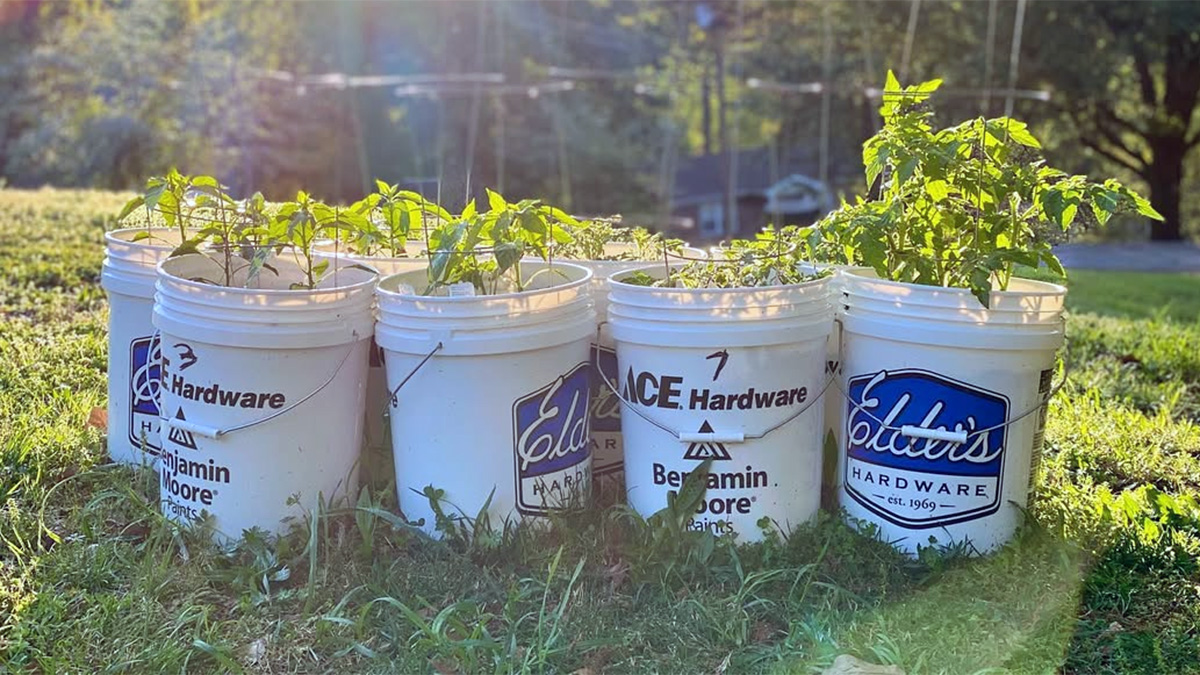Create a Productive Vegetable Garden Using 5 Gallon Buckets
 @h4rdwar3/Instagram
@h4rdwar3/Instagram
Container gardening is becoming increasingly popular as more people look for ways to grow fresh produce in small spaces. One simple, affordable, and highly effective method is using 5 gallon buckets. Whether you’re working with a small balcony, a patio, or just want a portable gardening solution, bucket gardening offers an accessible way to enjoy home grown vegetables.
Benefits of growing vegetables in 5 gallon buckets
Growing vegetables in buckets is ideal for limited spaces. Apartment dwellers, urban gardeners, or renters can easily set up a productive garden without permanent installations. Buckets make gardening convenient because they’re mobile, allowing gardeners to move plants easily according to sunlight exposure or weather conditions. Additionally, bucket gardens typically have fewer problems with weeds and pests due to their contained environment, making management simpler and more effective.
Choosing the right bucket
When selecting buckets for gardening, prioritize food-safe containers. Look for buckets marked as food-grade to ensure harmful chemicals don’t leach into your soil and crops. You can source inexpensive buckets from restaurants, grocery stores, or home improvement stores. Be sure to thoroughly clean your buckets using mild soap and water before planting.
Preparing your buckets for planting
Good drainage is critical for healthy plants. Drill several drainage holes at the bottom of your bucket, about ½ inch in diameter, evenly spaced to ensure excess water can easily escape.
Use a high-quality, well-draining soil mix designed specifically for container gardening. Good potting soil combined with compost and perlite or vermiculite can help maintain the right moisture balance.
Some gardeners add a layer of gravel or small stones at the bottom of buckets to improve drainage. However, this step is optional, as properly prepared drainage holes usually suffice.
Best vegetables to grow in 5 gallon buckets
Tomatoes
Tomatoes thrive in 5-gallon buckets, especially bush or dwarf varieties such as Patio or Roma. Provide sturdy support stakes or cages to help them grow upward and prevent branches from breaking under fruit weight.
Peppers
Peppers are excellent bucket plants. Both bell and chili peppers grow well in buckets. They require similar conditions to tomatoes—full sun and warm temperatures. Provide support if plants become heavy with fruit.
Cucumbers
Cucumbers grow rapidly and benefit from vertical support like trellises or stakes. Choose compact varieties such as bush cucumbers to ensure they thrive within the bucket’s limited space.
Beans and peas
Beans and peas grow efficiently in buckets. Bush beans are especially well-suited because they require minimal support. Pole beans or peas require a small trellis or stakes to climb.
Root vegetables
Carrots, radishes, and beets flourish in deep buckets. Choose shorter varieties like “Little Finger” carrots or “Cherry Belle” radishes, which mature quickly and adapt perfectly to container gardening.
Leafy greens
Lettuce, spinach, kale, and other leafy greens are perfect bucket crops. They require minimal space, prefer cooler weather, and allow you to harvest continually by picking outer leaves regularly.
Herbs
Basil, parsley, cilantro, rosemary, and mint thrive in buckets. Herbs add flavorful and aromatic variety to your garden and meals. They grow quickly and often produce continuously if harvested regularly.
Planting your bucket vegetable garden
Decide between starting your plants from seeds or purchasing seedlings. Seeds offer greater variety and lower costs but require additional time to grow. Seedlings speed up your garden’s establishment but limit plant selection.
Plant your seeds or seedlings according to recommended depths and spacing. Avoid overcrowding; for instance, plant only one tomato or pepper per bucket, while leafy greens can accommodate several plants per bucket. Label each bucket to track plant varieties and care requirements.
Caring for your bucket vegetable garden
Proper watering is essential. Container plants dry out faster, so monitor your buckets daily. Water when the top inch of soil feels dry. Overwatering can cause root rot, while underwatering can stress and stunt plant growth.
Feed your plants using a balanced, water-soluble fertilizer every 2-4 weeks. Fertilizing provides essential nutrients typically depleted quickly in container gardens.
Position buckets where plants receive adequate sunlight—ideally 6-8 hours per day. Adjust bucket placement if you notice plants leaning towards the light.
Common problems and troubleshooting
Pests occasionally challenge bucket gardens. Regularly inspect your plants for insects like aphids or caterpillars. Use organic solutions like neem oil or insecticidal soap to manage pests without harsh chemicals.
Yellowing leaves or stunted growth may indicate nutrient deficiencies. Apply a balanced fertilizer as needed, and maintain proper watering habits to prevent stress-induced diseases like powdery mildew or root rot.
Harvesting and maximizing your yield
Harvest vegetables regularly to promote continuous production. Pick tomatoes, peppers, and cucumbers at peak ripeness. Leafy greens like lettuce and spinach should be harvested often by cutting outer leaves to stimulate new growth.
Succession planting—sowing new seeds or seedlings as soon as you harvest previous plants ensures a continuous supply of fresh produce. By timing your planting carefully, you avoid periods when buckets sit empty, making efficient use of limited space. For example, after harvesting fast-growing crops like lettuce or radishes, you can quickly plant new seeds or young plants in the same bucket. This technique maximizes your gardening productivity, ensuring you always have something fresh to harvest.
Conclusion
Creating a productive vegetable garden using 5 gallon buckets is practical, rewarding, and achievable. Regardless of your space limitations, bucket gardening provides an affordable and effective solution to enjoy fresh vegetables. With careful planning, proper care, and creative arrangements, you’ll soon harvest delicious, home grown produce from your bucket garden.
